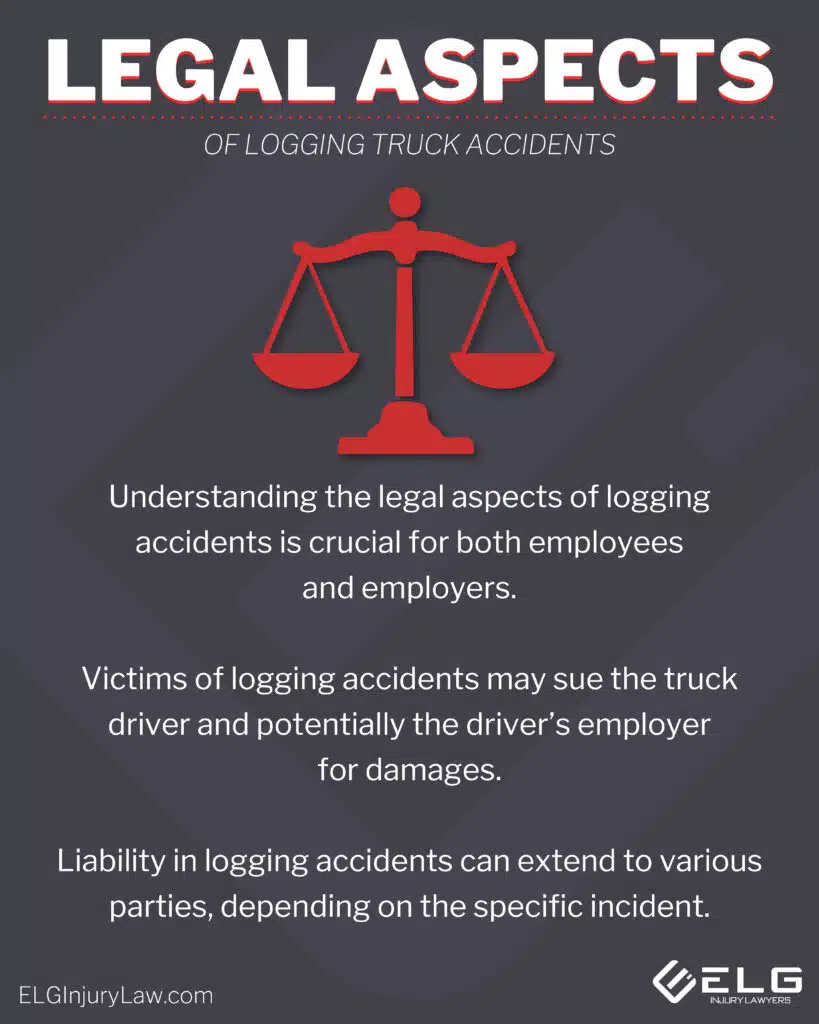
Logging accidents are a major concern in the industry, often resulting in serious injuries and fatalities. This article explores the primary causes of these accidents and how to prevent them, providing essential information for loggers and companies to improve safety.
Key Takeaways
- Falling objects, equipment failures, and vehicle accidents are leading causes of logging accidents, necessitating proper safety measures to minimize risk.
- Driver fatigue and inadequate training significantly increase the likelihood of accidents; implementing stringent safety protocols and ensuring proper training are essential.
- Regular equipment maintenance, proper cargo loading, and the consistent use of personal protective equipment are critical strategies for preventing logging injuries and fatalities.
Common Logging Accidents
Logging operations frequently result in serious injuries and fatalities, affecting not only the workers but also motorists. Collisions involving logging trucks are particularly devastating, often leading to fatalities due to the sheer size and weight of the vehicles involved. Additionally, loggers face significant risks from falling logs and limbs, which account for nearly 25% of accidents in the industry, including crashes.
The logging industry is renowned for its hazardous nature, with heavy machinery and unpredictable natural elements posing constant threats. Understanding the major types of logging accidents is crucial for implementing effective safety measures and reducing the incidence of these dangerous events.
Falling Objects
One of the most common hazards in the logging industry is falling objects. This includes dead limbs, improperly secured logs, and even ice accumulation on trees. Falling objects can cause severe injuries or fatalities, making it essential to secure loads properly during transport. Ensuring that logs are correctly loaded and secured on log trucks can prevent cargo shifts and falls during transit.
Using proper equipment and techniques to secure logs helps reduce logging accidents related to falling objects. These precautions can significantly minimize the risk of severe injuries and fatalities, creating a safer working environment for loggers and other road users.
Equipment Failures
Equipment failures are another major cause of logging accidents. Regular maintenance of logging equipment is crucial to prevent malfunctions and ensure safety. Adhering to the manufacturer’s instructions for routine checks can significantly minimize the risk of equipment failures and the associated severe injuries.
A notable case study highlighted the consequences of equipment failure in logging operations, where a malfunction led to severe injuries for the worker involved in most cases. This underscores the importance of following strict maintenance protocols, which not only protect workers but also enhance operational efficiency.
Vehicle Accidents

Distracted driving is another significant issue among commercial truck drivers, impacting their ability to operate vehicles safely. Misjudgments by other drivers near large trucks, often due to a lack of familiarity with truck dimensions and blind spots, create additional hazards in the traffic situation involving passenger vehicles.
These factors, combined with aggressive driving behaviors such as excessive speed, speeding, and tailgating, significantly increase the likelihood of accidents. Obtaining a commercial driver’s license is essential for ensuring that drivers are properly trained to handle these challenges.
Rollover accidents are particularly dangerous due to their potential for extensive damage and high fatality rates. Factors such as road conditions, weather, and truck speed greatly influence the likelihood of high-risk rollover accidents. Distracted driving behaviors among truck drivers, including texting, talking on the phone, and eating while driving, further contribute to the risk.
Let's Settle For More... Get Your FREE Case Review Today.
Let's Settle For More... Get Your FREE Case Review Today.
Factors Contributing to Logging Accidents
Various major factors contribute to the most common causes of the high incidence of logging accidents. Environmental conditions such as uneven terrain and inclement weather significantly increase the danger of logging work. Loggers face operational hazards like falling trees and risks associated with heavy equipment, which can lead to serious injuries.
Driver fatigue and improper vehicle maintenance also play critical roles in logging accidents. Issues like unbalanced loads and worn tires can lead to severe accidents if not addressed promptly. Implementing stringent safety protocols is essential for reducing the risk of accidents in logging operations.
Poor Weather Conditions
Poor weather conditions are a significant factor contributing to logging accidents. Inclement weather can lead to dangerous conditions like slick roads and reduced visibility, aggravating the risk of accidents. Snow and ice accumulation can create hazardous working environments for loggers, increasing the chances of accidents due to poor directional control.
Reduced visibility and slick surfaces significantly raise the likelihood of accidents in logging operations. Loggers should always assess weather conditions and delay operations if necessary to ensure safety. By doing so, they can mitigate the risks associated with poor weather conditions and reduce visibility to protect themselves and others.
Driver Fatigue
Driver fatigue is a critical factor that can significantly increase the likelihood of accidents on the road. A log truck accident attributed to driver fatigue demonstrated how insufficient rest led to impaired decision-making and increased the risk of a crash. When the driver fell asleep, extended hours without proper breaks severely impaired a driver’s alertness and response capabilities, increasing the chance of accidents.
Recognizing the dangers of driver fatigue is vital for improving safety protocols within the logging industry. Regulating work hours and ensuring drivers get adequate rest minimizes the risk of fatigue-related accidents, enhancing overall safety.
Inadequate Training
Inadequate training on equipment handling and safety procedures contributes to a higher frequency of accidents among many workers in logging. Ensuring that all workers receive proper training is essential to mitigate these risks and create a safer working environment.
Safety Measures to Prevent Logging Accidents
Implementing effective safety measures is crucial in preventing logging accidents. Regular maintenance of logging equipment is vital, as neglect can lead to serious accidents and injuries. Logging accidents often showcase the severe risks associated with the industry, emphasizing the need for strict safety protocols.
Case studies of logging accidents reveal the critical hazards associated with logging operations, reinforcing the need for effective safety protocols. By adopting these measures, the frequency of accidents can be significantly reduced, ensuring a safer environment for workers.
Personal Protective Equipment
Using appropriate personal protective gear, including helmets and gloves, is crucial to safeguard loggers from potential injuries. Properly fitted personal protective gear enhances worker safety in logging environments. A well-fitted helmet can protect loggers from falling objects, while gloves provide grip and protect against cuts.
The consistent proper use of personal protective equipment is essential in logging operations to prevent workplace injuries. By ensuring that all workers are equipped with the necessary gear, including steel-toed boots, the risk of injuries can be significantly minimized.
Proper Cargo Loading
Securely loading logs on trucks is vital to prevent accidents caused by cargo shifting during transit. Correctly secured cargo prevents shifting that could lead to dangerous situations during transport. Adhering to correct loading procedures can prevent logs from shifting during transport, minimizing the risk of rollovers.
Improperly loaded logs on trucks can fall off and injure motorists. Ensuring that logs are loaded and secured correctly is essential for the safety of both the truck drivers and other road users.
Regular Equipment Maintenance
Regular equipment maintenance is crucial to preventing logging accidents and ensuring the safety of workers. Frequent checks and servicing of equipment, such as chainsaws and trucks, are essential to avoid mechanical failures that can lead to accidents. Chainsaw malfunctions can lead to severe lacerations or even amputations if not properly maintained.
Conducting routine checks on motor vehicle components helps identify potential issues before they lead to accidents. Regular equipment maintenance significantly reduces the risk of accidents due to equipment failure.
Negligence in duties can lead to a company’s liability in a truck accident. Trucking companies can be held liable for accidents involving their drivers under vicarious liability. Understanding drivers’ adherence to regulations is vital for the success of legal cases.
Liability in Logging Accidents
Liability in logging accidents can extend to various parties, including employers and equipment manufacturers, depending on the specific incident. Liability may arise from failure to adhere to safety regulations, equipment defects, or actions of other drivers in the incident.
Logging companies can be held accountable if they fail to adhere to safety regulations or hire qualified drivers. Understanding the potential liabilities is crucial for both logging companies and employees to ensure a safe working environment.
Workers’ Compensation Claims
Workers’ compensation benefits provide financial support for medical care and wage replacement for injured employees, independent of fault. These benefits cover medical expenses and lost wages to employees injured on the job, regardless of fault.
Consulting a specialized attorney can significantly enhance the chances of obtaining fair compensation for workplace injuries. Consulting with ELG Injury Lawyers, who specialize in logging accidents, can enhance the chances of receiving fair compensation.
Seeking Legal Assistance
Consulting with ELG Injury Lawyers can provide essential guidance on legal matters and help ensure fair compensation. Understanding legal responsibilities and rights is crucial for logging companies and injured workers involved in accidents.
Liability in logging accidents may fall on various parties, such as employers, equipment manufacturers, and other drivers, depending on the specific circumstances of each case.
Real-Life Examples of Logging Accidents
Examining real-life logging accidents reveals the inherent dangers of logging operations and stresses the necessity for strict safety measures. A notable logging accident involved a tree falling onto a logging truck, resulting in severe injuries to the driver. Another case highlighted the consequences of equipment failure, where a logging truck’s hydraulic system malfunctioned, causing a catastrophic accident.
These incidents underline the critical need for improved safety protocols and equipment maintenance in logging operations, especially during critical events. These examples highlight the importance of adhering to safety measures to prevent similar future accidents.
Case Study: Equipment Failure
In the logging industry, equipment failures can lead to severe injuries, highlighting the risks associated with using faulty machinery. Failed equipment, such as chainsaws or heavy machinery, can result in serious injuries or fatalities for loggers, especially if trees are felled improperly.
Routine maintenance and adherence to the manufacturer’s instructions are essential practices to help prevent equipment failures and ensure worker safety. Implementing strict maintenance protocols can significantly reduce the risk of accidents caused by equipment failure in the logging industry.
Case Study: Driver Fatigue
A log truck accident was attributed to driver fatigue, demonstrating the importance of regulating work hours to enhance safety. Driver fatigue is a significant factor affecting safety in the logging industry. Fatigue contributes to the increasing number of accidents, highlighting the need for stricter safety measures in logging.
Regulating work hours for drivers is crucial to minimize fatigue-related accidents in the logging sector. Ensuring drivers receive adequate rest significantly reduces the risk of fatigue-related accidents, improving overall safety and complying with federal regulations. However, long hours can contribute to driver fatigue, making control of regulation even more essential, especially when drivers work for consecutive hours.
Frequently Asked Questions
What are the most common causes of logging accidents?
The most common causes of logging accidents are falling objects, equipment failures, and vehicle accidents, often exacerbated by poor weather, driver fatigue, and inadequate training. Addressing these factors can significantly enhance safety in logging operations.
How can falling objects be prevented during logging operations?
To prevent falling objects during logging operations, ensure logs are securely loaded and equipped with proper personal protective gear, while also prioritizing regular equipment maintenance and comprehensive worker training. This proactive approach significantly enhances safety on-site.
What legal actions can be taken if someone is injured in a logging accident?
Victims of logging accidents can take legal action by suing the truck driver and their employer for damages. It’s advisable to consult specialized attorneys to improve the chances of securing adequate compensation for medical expenses and lost wages.
How does driver fatigue contribute to logging accidents?
Driver fatigue significantly impairs decision-making and slows response times, increasing the likelihood of logging accidents. It is essential to take regular breaks and maintain alertness to ensure safety on the road.
What safety measures can be implemented to reduce the risk of logging accidents?
To reduce the risk of logging accidents, implement proper personal protective equipment, ensure secure loading of logs, conduct regular equipment maintenance, provide adequate training for workers, and regulate work hours to minimize fatigue. These measures collectively enhance safety in the logging industry.
Last updated Wednesday, August 6th, 2025







